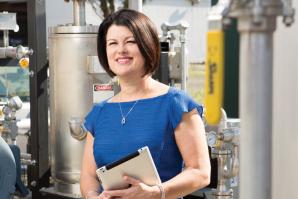Among the many risks involved in commercial real estate lending today, energy risk is so poorly understood that lenders simply do not have the tools they need to measure it. This ignorance of energy risk — the likelihood that higher energy costs compromise a building owner’s ability to make their mortgage payments — leads to inflated loans. This is because both efficient and inefficient buildings are judged the same in the eyes of the lender. But UC Berkeley researchers have developed a tool they claim would measure the net benefit of energy savings investments. This would help lenders devise a more accurate loan amount and free up funding for building owners to move forward with energy retrofits, at once capturing savings and protecting the environment.
There are many problems and challenges in assessing energy risk. That much gray area makes lenders nervous, makes borrowing money to finance energy improvements more expensive and creates a disincentive to retrofit buildings for energy efficiency.
Currently, the only tangible data lenders can rely on is the amount by which energy costs are likely to increase, and the news isn’t good, especially here in California. Californians can expect to see energy costs rise up to 5 percent annually for the next decade, according to Navigant Consulting, an international management consulting firm with expertise in energy markets. These projections are based on a number of factors, ranging from increased congestion on transmission lines to compliance costs associated with the state’s requirements for renewable energy purchases.
That makes it easy to measure how costs are going to increase and how that will affect a borrower’s ability to repay a loan. But there hasn’t yet been a means of assessing how preparing a building for more energy efficiency would actually decrease the risk of default. Without such a formula to work from, lenders must underwrite loans presuming all buildings are energy lemons.
“Since lenders can’t distinguish between efficient and inefficient buildings, they treat all buildings as inefficient,” says Nancy Wallace, professor with the Haas School of Business at UC Berkeley, who also specializes in designing mortgage contracts. “Thus, current building owners generally don’t realize lower interest rates on more efficient buildings.”
In this paradigm, building owners looking for capital to finance energy efficiency improvements suddenly face an absurd situation: Lenders automatically presume building owners will have the highest possible energy bills, and to protect themselves, they charge higher interest rates on loans, even if the money is being borrowed to make improvements that will keep energy costs down.
That was the scenario John Tarlton encountered when he decided it was time to make his 900,000-square-foot business park more energy efficient.
“The kicker was the financing — we had to get creative,” he says. “One-third of the cost came from rebates and zero-interest loans from PG&E, and another third came from the energy savings themselves. For the rest, we had to get a loan, and all we could get was an unsecured debt loan, one of the most expensive options available.”
Compounding the problem is that when building owners look at the math involved in expensive loans, they may not see the time and money needed for the investment as worthwhile. In today’s market, tenants may not be willing to pay higher rents for more energy-efficient buildings, meaning owners may not be able to recoup the cost of an energy efficiency retrofit on an attractive timetable. As Wallace outlines, it’s a chicken-and-egg scenario: Tenants must be confident they’ll have lower energy costs before they’re willing to pay higher rents, and building owners must be confident they can get higher rents before they’ll make energy-saving investments.
“There’s a real challenge in convincing owners it’s worth the time and money to undertake these kinds of improvements,” says Clayton Gantz, a partner with Manatt Phelps & Phillips. “At the moment, energy costs are generally not huge dollars relative to the value of a building, per se. So a $500,000 expense to garner a 10 percent reduction in costs may not be on top of the list of pressing issues.”
Even Tarlton’s successful experience, which shaved 20 to 30 percent off a seven digit annual energy bill, reflects what Gantz describes. Tarlton would not release exact figures, but said that as attractive as the energy cost savings were, they were tempered by the high cost of the money he borrowed.
“Our projects still save money, save energy and have a positive return, but we’d have made more money if we’d been able to borrow at a lower cost of capital,” he says.
Tarlton’s example is an exception to the norm in that he actually went through with the upgrades. More often owners balk, and what results is a Catch-22. Because of presumed high energy risk, lenders are overpricing their loans to the extent that building owners aren’t seeing enough of a return to justify the financing costs. The consequence creates an unfortunate cycle: The buildings remain inefficient, commercial real estate continues to account for 20 percent of U.S. energy consumption (according to the U.S. Department of Energy), and the presumption of high energy risk is justified.
“We know there’s very little retrofitting going on because cost of borrowing money is too high,” Wallace says, adding that it may take decades for the commercial real estate sector to become more energy efficient.
The only way to break the cycle is to develop new financial approaches that help lenders explicitly account for the energy risk of individual buildings, something Wallace and her colleagues believe they have accomplished.
“The purpose of our research was to show how tools commonly used in interest rate management can be applied to energy risk management, especially in terms of natural gas and electricity consumption,” she says. “It provides a tool for pricing loans in an actuarially fair way by explicitly incorporating energy risk and efficiency measures into commercial mortgage valuation and underwriting.”
The resulting model provides for the first time a tool property owners and lenders can use to measure the actual net benefits of energy-saving investments. If implemented, it can protect lenders from providing too much mortgage debt relative to the riskiness of the property. For borrowers able to demonstrate how their lower energy costs would lower the risk of default, it can lead to much more attractive loan features, starting with better interest rates.
The tool’s utility also goes beyond financing for energy efficiency improvements. As newer, more efficient buildings are proposed, the tool can show lenders and investors how those efficiencies can help earn an attractive return on investment.
Wallace’s research has not yet been published in a peer-reviewed journal, however she and her co-authors intend to submit it for review in spring. If accepted and validated by the lending industry, their research could help kick start a much more serious movement among building owners to upgrade their energy-gobbling properties and thrust the commercial real estate market into a new and prosperous energy future. Given the importance of conservation to a broader national strategy to lower energy costs and reduce demand for foreign energy supplies, a more efficient commercial sector would no doubt offer benefits to all energy consumers.
Recommended For You

Commercial Lending Forecast
Softening standards with a chance of loans
This year could provide some of the first expansions in bank lending since 2008. So is the market back up to speed? No. But banks are slowly and smartly increasing their appetites for commercial lending, and the Capital Region will see its share of transactions.




